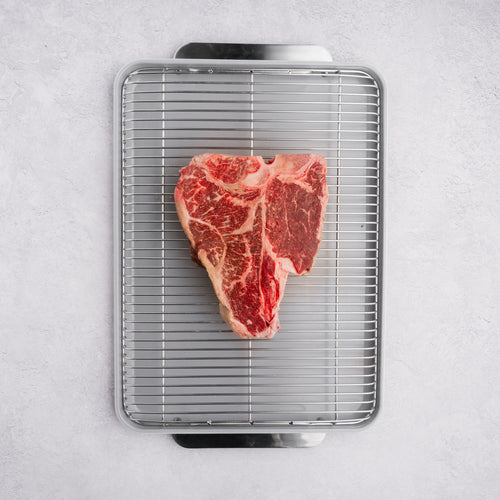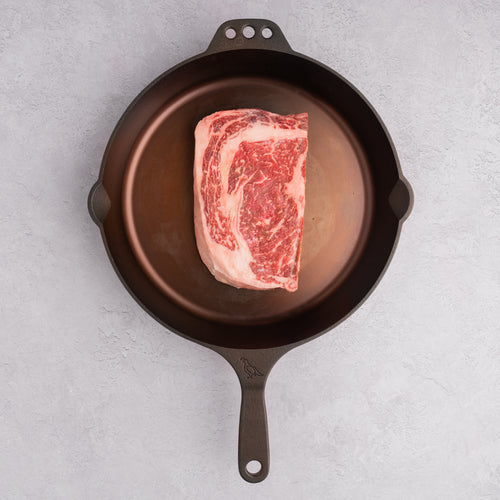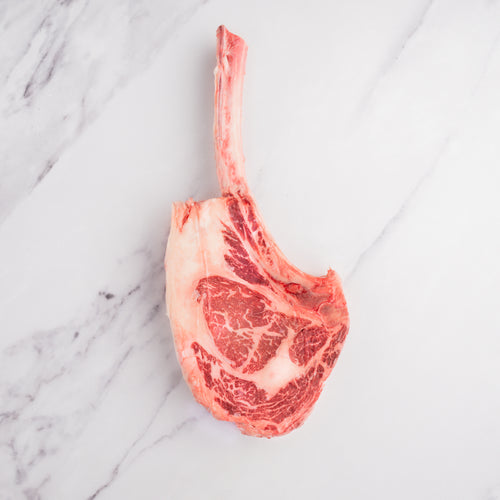Porterhouse vs. Ribeye: Key Differences, Best Uses & Which Steak to Choose

Porterhouse vs. Ribeye: Key Differences, Best Uses & Which Steak to Choose
You’re scrolling through our collection of steaks, trying to decide between two standout options: the ribeye and the porterhouse. They look incredible and promise big flavor—but how do you know which one is right for your meal?
These two cuts are among the most popular choices for steak lovers, and while they share some similarities, they’re very different in taste, texture, and the way they cook. Choosing the right cut makes a great steak experience even better.
At Snake River Farms, we’ve spent decades raising and perfecting the world’s highest quality beef. In this guide, we’ll break down the similarities, differences, and best uses for the ribeye and porterhouse so you can choose the perfect steak for your next meal.
Curious about more steak options? Explore our guide to different types of steak.
|
Table of Contents |

What is a Ribeye?
Ribeye is one of the most recognizable and best-loved steak cuts out there. Known for its rich marbling and full-bodied flavor, it’s a favorite for steak lovers who want a tender, juicy experience every time. Whether you're cooking at home or ordering at a restaurant, the ribeye delivers bold beefy flavor and a buttery texture that’s hard to beat. If you're deciding between ribeye vs porterhouse, here’s what makes ribeye stand out.
Where it Comes From
A classic ribeye steak includes several muscles that each contribute to its flavor and texture:
- Longissimus dorsi is the large central portion, also called the “eye” of the ribeye. It’s known for its tenderness and smooth texture.
- Spinalis dorsi is the outer cap, sometimes called the ribeye cap or deckle. It’s prized for its intense marbling and deep flavor.
- Complexus is a smaller, more delicate muscle that may be present in some cuts depending on where the steak is trimmed.
These muscles are held together by sinew and intramuscular fat, which melts during cooking to create the signature buttery texture of a ribeye.

Key Characteristics: Marbling, Tenderness, and Rich Flavor
Known for its abundant marbling, the ribeye delivers unmatched richness and tenderness in every bite. Our American Wagyu ribeyes raise the bar, offering a smooth, luxurious texture with pronounced marbling throughout. If you’re looking for a steak that’s both flavorful and tender, the ribeye delivers.
“So tender, delicious, and flavorful. Most definitely ordering from SRF again. Thank you Luke for your amazing customer service”
- Debra, Verified Buyer
Bone-In vs. Boneless Ribeye
Choosing between bone-in and boneless ribeye comes down to your cooking style and presentation goals.
- Bone-in ribeyes, like our cowboy and tomahawk steaks, retain more moisture as they cook and offer a bolder look on the plate. The bone also helps moderate heat, which can enhance the final texture and flavor.
- Boneless ribeyes are easier to handle, cook more evenly, and offer a consistent, no-fuss eating experience. Cuts like the ribeye filet are perfect for quick grilling or searing in a cast iron skillet.
Both options offer the same rich, beefy taste that makes ribeye a favorite. It just depends on how you want to serve and cook your steak.
“This is the only ribeye I ever want to eat again! I could have cut it with a butter knife, and it was so incredibly delicious- Snake River Farms, you are stuck with me for life!! I will be trying everything you have to offer. Thank you!”
- Jen P., Verified Buyer
Want to get the most out of your ribeye? Whether you choose bone-in or boneless, check out our step-by-step guide to cooking a ribeye steak for tips on achieving the perfect sear, doneness, and flavor.
Ready to try one of the best cuts of steak? Shop American Wagyu Ribeye Steaks.

What is a Porterhouse?
Porterhouse is a steakhouse classic, known for its generous size and two-in-one experience. It combines the tenderness of filet mignon with the bold flavor of a New York strip, separated by a signature T-shaped bone. This cut delivers a mix of textures and flavors in a single steak, making it a go-to for anyone who wants the best of both worlds. If you're weighing ribeye vs porterhouse, here's what sets the porterhouse apart.
Where it Comes From
A porterhouse steak is cut from the short loin, a section of the loin primal located just behind the ribs and in front of the sirloin. It features two of the most prized muscles in the steak world:
-
Tenderloin (Filet Mignon) is the smaller, more delicate side of the cut. It’s known for being exceptionally tender with a fine, buttery texture.
- Strip Loin (New York Strip) is the larger side of the porterhouse, offering a firmer bite and bold, beefy flavor.
These two muscles are separated by a T-shaped bone, which helps the steak retain moisture and adds extra flavor during cooking. To qualify as a true porterhouse (not just a T-bone), the filet portion must be at least 1.5 inches wide at its widest point.

Key Characteristics: Size, Texture, and Dual-Flavor Experience
Porterhouse steaks are known for their generous size and unique combination of textures. Since they include both the tenderloin and strip loin, each bite offers a different experience.
-
Filet side is buttery and lean with a smooth, tender bite; ideal for those who love a more delicate steak.
- Strip side brings the classic steakhouse flavor, with a firmer texture and bold beefiness that stands up well to high-heat cooking.
Together, these two cuts create a dynamic flavor experience in a single steak. Thanks to its impressive size and dramatic presentation, the porterhouse is also one of the most popular cuts to serve for celebrations or shared meals.
“My husband just BBQed this bad boy and in one word it was AWESOME. The best steak I’ve ever had, and my dad used to raise beef cattle and I grew up on great steaks, or so I thought till I tried this porter house. Absolutely absolutely the best!”
- Jazzy, Verified Buyer
Porterhouse vs T-Bone: What’s the Difference?
Porterhouse and T-bone steaks are easy to mix up — they look almost identical at first glance. The main difference comes down to size and where the cut is made along the short loin:
- Porterhouse steaks are cut farther back on the shortloin and have a larger portion of filet. If the filet is at least 1.5 inches wide, it’s officially a porterhouse.
- T-Bone steaks are cut closer to the front of the loin, so they have a smaller filet and slightly less overall meat.
That extra bit of filet makes the porterhouse a bigger, heartier cut — and a favorite for anyone who wants the best of both worlds on their plate.
Want to learn how to cook your porterhouse steak to perfection? Check out our step-by-step guide here.
Experience both cuts in one impressive steak. Shop Wagyu Porterhouse Steaks.

Porterhouse vs. Ribeye: Key Differences
Trying to decide between porterhouse and ribeye? While both cuts are rich, flavorful, and deeply satisfying, they have some noticeable differences that can help guide your choice. From size and fat content to texture and taste, here’s a closer look at how these two steaks stack up.
Porterhouse vs. Ribeye at a Glance
Still deciding between the porterhouse and ribeye? Here’s a quick side-by-side comparison to help you find the right steak for your next meal.
| Highlights | Porterhouse | Ribeye |
|---|---|---|
| Flavor | Balanced: tender + hearty | Rich, beefy, well-marbled |
| Texture | Filet = tender, Strip = firmer | Juicy and consistent throughout |
| Cooking Method | Reverse sear, sous vide | Grill, cast iron, steakhouse |
| Ideal For | Special dinners, sharing | Flavor lovers, solo meals |
| SRF Products | Shop Porterhouse | Shop Ribeye |
Size & Cut
The ribeye is taken from the rib section, typically boneless or bone-in with a central eye and surrounding cap. The porterhouse is a much larger cut from the short loin and includes two distinct steaks in one — the New York strip and the filet mignon — separated by a T-shaped bone.
Marbling & Fat Content
Ribeye is famous for its abundant intramuscular fat (also called marbling), which melts during cooking and delivers a rich, juicy bite. Porterhouse has excellent marbling in the strip portion, but the filet side is leaner and less fatty overall.
Texture & Tenderness
Porterhouse gives you two textures in one steak: the tender, buttery filet and the firmer, more structured strip. Ribeye has a consistent, juicy tenderness. Porterhouse offers contrast: the melt-in-your-mouth filet and the firmer strip.
Flavor Profile
Ribeye packs a bold, beefy flavor thanks to its fat content and complex muscle structure. It’s rich, savory, and indulgent. Porterhouse offers a more balanced flavor experience, pairing the lean, subtle taste of filet with the heartier bite of strip steak.
Want to get the best cook on either cut? Learn how to reverse sear a steak for even results and maximum flavor.

Ribeye vs. Porterhouse: Which Steak Should You Choose?
When it comes to choosing between ribeye and porterhouse, every steak enthusiast has their personal favorite. Both cuts offer a unique steak experience, but it all depends on what you are craving, whether it’s intense flavor, tenderness, or the perfect steak for sharing. Here are our expert recommendations:
For Flavor Seekers: Ribeye
If rich, beefy flavor is your top priority, ribeye is the cut for you. Its high level of marbling delivers a juicy, full-bodied bite with every slice. As the fat renders during cooking, it creates that signature steakhouse taste that ribeye fans know and love.
For Unmatched Tenderness: Porterhouse
The porterhouse offers two steaks in one, featuring a tenderloin on one side and a New York strip on the other. The tenderloin is exceptionally soft and buttery, making the porterhouse a strong choice if you prioritize texture and tenderness.
For Sharing and Presentation: Porterhouse
Planning a dinner for two or a special gathering? The porterhouse makes an impressive statement. With its large size and classic T-bone structure, it delivers both a visual impact and a combination of textures that’s ideal for sharing.
Cooking Methods: What Works Best
Both ribeye and porterhouse perform well using steakhouse techniques that prioritize even heat distribution and a perfect sear. The right technique brings out the best in every bite—whether you're grilling a ribeye or reverse searing a porterhouse.
Ribeye is more forgiving and flavorful, ideal for:
- Grilling to develop deep flavor and enhance marbling
- Steakhouse Method to achieve even doneness with a crisp crust
- Cast iron searing for control and steakhouse results indoors
Get the high-heat, steakhouse crust you crave—see the method in action:
Porterhouse benefits from more precise methods to balance its two cuts:
- Reverse searing helps cook both sides evenly
- Sous vide followed by a quick sear ensures edge-to-edge doneness
- Slow roasting in the oven with a final cast iron sear creates a well-balanced finish
See how the reverse sear method delivers steakhouse-quality results at home—watch now:
Choosing the Right Steak for You
Still deciding? Here’s how to narrow it down.
-
Think about your appetite and audience.
If you're cooking for yourself and want maximum flavor, go with ribeye. If you're serving a special dinner or want a cut made for two, the porterhouse delivers both variety and visual appeal.
-
Consider your texture preference.
If you're cooking for yourself and want maximum flavor, go with ribeye. If you're serving a special dinner or want a cut made for two, the porterhouse delivers both variety and visual appeal.
-
Consider your texture preference.
The ribeye offers consistent richness and a juicy bite throughout. The porterhouse’s tenderloin section offers a delicate, melt-in-your-mouth feel, while the strip provides a firmer, more traditional steak texture.
- Match the steak to your cooking method.
Ribeye is well-suited for high-heat methods and handles quick sears or grills with ease. Porterhouse requires more attention to ensure both the filet and strip are cooked properly but rewards the effort with a refined steakhouse experience at home.
- Pro tips for any cut:
-
- Pat the steak dry before cooking to help create a proper crust
- Use a meat thermometer to avoid guesswork
- Rest the steak before slicing to keep juices locked
Want more tips? Check out our Guide: How to Cook a Steak for techniques that apply to both ribeye and porterhouse.
Frequently Asked Questions about Porterhouse vs Ribeye
Which is better, porterhouse or ribeye?
Is porterhouse the king of steaks?
Is ribeye the best cut of steak?
Is porterhouse a cheap steak?
What 2 steaks are in a porterhouse?
Final Take: Ribeye vs Porterhouse
Both are exceptional cuts, but each offers a different steak experience. If you’re after rich, beefy flavor with plenty of marbling, the ribeye is your go-to. Prefer something more tender with variety on your plate? The porterhouse gives you two premium cuts in one. We recommend trying both to discover your personal favorite. Explore our full selection of steaks and taste the difference of American Wagyu from Snake River Farms.
Want to keep exploring? Check out our guide to different types of steak to find your next favorite cut.







